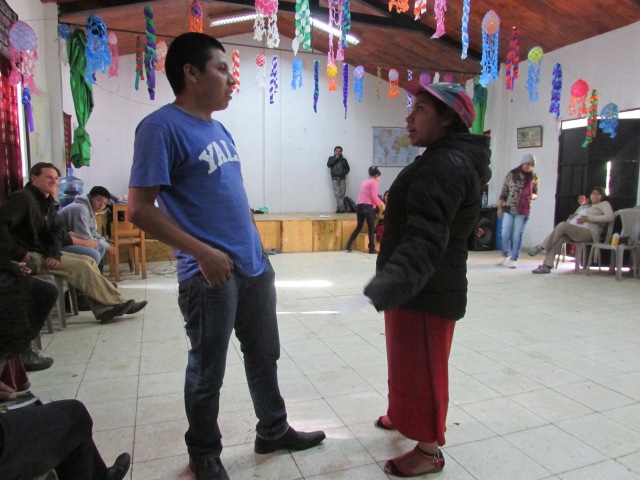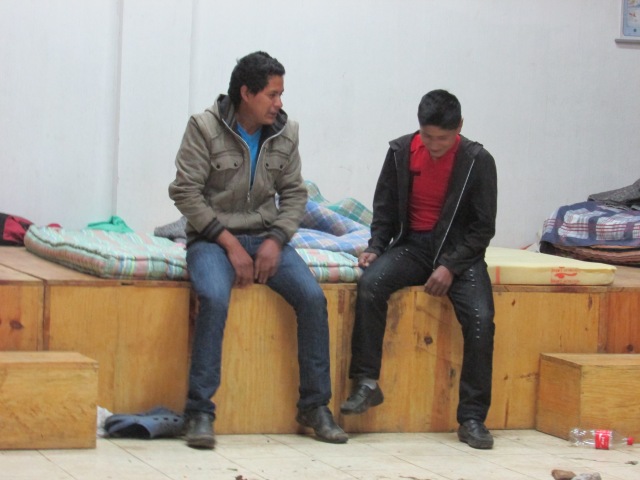Each year, the Connecting Peoples program organizes a week long service activity, where many young people of Guatemala and El Salvador gather to discuss a relevant topic. Last year we discussed the issue of migration, and through skits, the youth acted out the realities of each of their contexts.
One of the skits was about a mother of two children who was abused by her husband. Tired of the abuse of their mother, the boys decide to migrate north in order to generate income and provide the means to remove their mother from her violent environment. This skit promteded me to ask: is abuse against women and gender inequality also as a cause of migration?
While this drama portrayed a woman in a stationary position without migrating, reality shows that the numbers of migrant women is increasing. According to the United Nations Population Fund (UNFPA), in 2013, the number of migrant women from Latin America and the Caribbean amounted to more than half of the total number of migrants.
If the majority of migrants from Latin America and the Caribbean are women, why do they remain invisible? Why do gender-based causes of migration not receive attention? Why is there not more attention centered on what happens to women when they arrive at destination countries?
The Migration Policy Institute (MPI) points that it was not until the early 80’s that the term ´migrants and their families´ ( male migrants, plus their wives and children) stopped being used, to include women as active migrants. This, however, represented more of a semantic change, which is still poor on practicality and considerations that take into account gender variables.
Ignoring women even though they make up more than half of the migrant population in Latin America, enables the absence of state responsibility and results in the maintenance of a high-profit business that significantly increases the Gross Domestic Product (GDP) of the sending countries. According to the World Bank, in 2014 remittances reached 16.9% of GDP in Honduras, 16.4% in El Salvador, 10% in Guatemala and 9.6% in Nicaragua. For United States, the country that receives the largest number of Central American migrants, the work of international migrants represents 32% of their GDP.
However, abuse against women does not simply start on their journey as migrants.

A few months ago, local students in the Ataverapaz area dramatized the story of an indigenous woman washing clothes on a rock in the river. In the drama, a man approaches the girl and starts to harass her sexually. When she resists, he throws a rock at her to kill her. The rock wounded her but did not kill her, yet she responds back the same way and does kill her aggressor, unintentionally. The sketch ended in the imprisonment of the girl for killing her attacker in self-defense. Unfortunately, this drama reflects many of the situations lived by women in the different contexts of their countries of origin.
The most tangible form of violence in Central America are the recurring ‘feminicides’. A femicide is a murder that is linked to contempt for women, sexism and the assumption that women are property. The sketch illustrates the attempt of a feminicide: the aggressor feels entitled to the body of the indigenous woman and tries to kill her when she defends her body. According to the Feminist Centre for Information and Action: “’femicide’ in the countries of Central America are shooting to the point that in some countries in the region, there are over 100 homicides per 100,000 inhabitant.s¨ The Economic Commission for Latin America and the Caribbean has reported that 90% of cases of femicide remain in impunity.
Violence against women is a vicious spiral system in different areas. Sexual street harassment as seen as normal and is not condemned. Women have less access to education assume much of the unskilled work in the manfacturing sector where they face exploitation, wage inequality and harassment. In the domestic sphere, abuse against women usually goes unreported due to fear of the spouse and the lack of trust in the judicial system.
As a woman begins her journey as a migrant her vulnerability increases. Amnesty International estimates that 60% of migrant women are victims of sexual abuse on their way north, although it is speculated that this amount could reach 80%. According to the UNPF, ¨Women migrants are particularly vulnerable to human trafficking for the purposes of sexual exploitation, a multimillion-dollar business. Trafficked women are exposed to sexual violence and sexually transmitted infections, including HIV, yet they have little access to medical or legal services.¨
Certainly, abuse to migrants on their way to the United States has gained media coverage compared with the almost zero visibility of the abuse women face in their destination country where the cruel discrimination and segregation of migrants is a real problem. During our week of service activities, a woman who worked as a cleaner and was deported from the US shared her experience: “There was an office which I was not allowed to clean, because the lady who worked there did not want a ´dirty illegal´ to touch her things.” Despiste these issues, the United States Supreme Court does not prioratize immigration reform that would benefit thousands of immigrants who are undocumented, allowing them to work temporarily under the protection of the law.
There are approximately 30,000 immigrants detained in the United States;10% are women. Human rights organizations have strong concerns about conditions at immigration detention centers, especially concerning sexual abuse, family separation, medical and mental health services, pregnancy and post-natal care, as well as access to legal counsel. The division of women’s rights at Human Rights Watch said: “Women in detention described violations such as shackling pregnant detained women or not following up on signs of breast and cervical cancer as well as affronts to their dignity. Given that immigration detention is the form of imprisonment with the fastest growth in the United States, these abuses are especially dangerous. They remain largely hidden from public scrutiny and effective oversight¨
If deported, the ´via cruxis´ of migrant women continues. The challenges faced at the time of repatriation can include: family separation, abstraction of their children born in the United States, trauma, financial problems, debts to coyotes, etc. Women who are deported usually find themselves living within an even harsher reality than the one they left before their journey and often try to migrate again.
The journey of the migrant woman is a complex reality that must be examined with a gendered perspective: one that assumes a specific context, gender and relationship with the different powers at each stage of their journey. The answers to the problem of migration must involve structural changes of the conditions that women are fleeing in their home countries. It needs to start with the visibility of migrant women and from there, target the creation of conditions and policies that ensure the non-exploitation of their labor, safety, sovereignty over their bodies, including zero tolerance of the discrimination they currently suffer , as well as sustainable change on the conditions in the country of departure.


